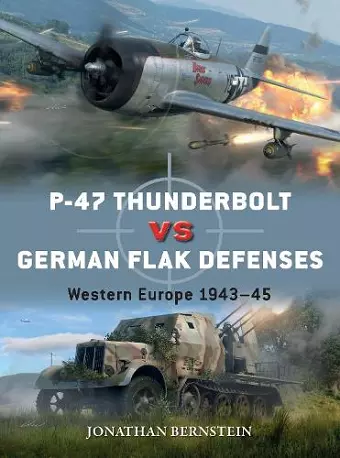P-47 Thunderbolt vs German Flak Defenses
Western Europe 1943–45
Jonathan Bernstein author Jim Laurier illustrator Gareth Hector illustrator
Format:Paperback
Publisher:Bloomsbury Publishing PLC
Published:28th Oct '21
Should be back in stock very soon

A detailed look at the tactics and techniques used by both P-47 fighter-bomber pilots and the German flak gunners charged with preventing their attacks. Analysis will focus on the employment of Allied tactical air power in Europe from 1943 and how German defences struggled to counter the overwhelming air threat.
Since the end of World War 2, the tactical air war over Europe has been largely overlooked by historians and authors alike in favour of analysis of the higher profile strategic bombing campaign. Involving just as many aircraft as the daylight heavy bombing campaign, the fighter-bombers (principally of the Ninth Air Force) wreaked considerably more havoc on German ground forces. Indeed, Thunderbolt units undertaking such missions effectively complemented the strategic campaign, ensuring the defeat of Nazi Germany. P-47 pilots paid a high price to achieve this victory, however, as the German flak arm was well equipped (nearly a quarter of all war-related production was devoted to anti-aircraft weaponry) with weapons of various calibres to counter tactical air power’s low to medium altitude threat. The USAAF four numbered air forces that saw action over the European continent suffered significant fighter-bomber losses to flak. The principle fighter-bomber from the summer of 1944 through to VE Day was the P-47D, with both dedicated ground attack units and squadrons that had completed their bomber escort tasking seeking out targets of opportunity across occupied Western Europe.
While heavy-calibre anti-aircraft fire was intended to both shoot down enemy aircraft and force bombers to drop their ordnance sooner or from higher altitudes, thus reducing bombing accuracy, low-altitude flak batteries put up a virtual ‘wall of steel’ for enemy fighter-bombers to fly through. Damaging a low-flying fighter-bomber made it easier for other flak gunners to track, engage and destroy it. Innovations like lead-computing gunsights gave gunners a higher probability of intercepting low-altitude fighters. Conversely, the appearance of air-to-ground rockets beneath the wings of P-47s gave pilots better standoff range and a harder-hitting punch when dealing with low and medium altitude flak units.
This volume analyses the tactics and techniques used by both P-47 fighter-bomber pilots and German flak gunners, featuring full-colour illustrations to examine the Allied tactical air power in Europe from 1943 and how German defences were overpowered by the air threat.
If you want to look at an analysis of how the P-47 fared against the formidable and numerous German Flak defenses then this is a book you need on your shelf. -- Todd Shughart * The Aviation Historian *
ISBN: 9781472846297
Dimensions: 246mm x 184mm x 2mm
Weight: 264g
80 pages